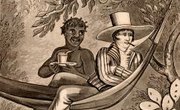The Renaissance began in the 1300s and ended in 1600. Although the time period was most noted for artistic creations, several technological and economic advances began during this era. Capitalism began during the Renaissance, and capital holding companies were formed to deal with trading in Russia, the Far East and other remote locations. Some well-known businesses that can trace their beginning to the Renaissance are shipping, banking, printing and bookkeeping.
Shipping
The Renaissance was a time of exploration and travel by ship. In 15th century Europe, sailors first began making ocean voyages for profit. Past civilizations had built navies but sailed mainly for political purposes. Naval technology had advanced to the point of making these voyages for profit possible. The growing merchant trade supplied the sailors with goods to transport and sell. The trading industry opened vast new markets during this period. Shipping and trading advances eventually brought opportunities for exploration and colonization to new lands. Christopher Columbus discovered the Americas during the Renaissance era.
Banking
The concept of banking began in the 13th century, but the practice became more widely adopted in the 14th century. With the beginnings of capitalism taking place in the Renaissance era, merchants and ship traders with Russia and the Far East needed an organized way to handle their cash flow. With the innovation of shipping for money came the need for the concept of banking. The first banks had their beginnings in the 14th century.
Bookkeeping
One great business innovation that began in the 13th century was double-entry bookkeeping. The societal rise of the mercantile society led to their control of the finance industry. Medieval Italian merchants developed the financial technique with the rise of the merchant and shipping industries.
Printing
The invention of printing, while related to the great literary works the Renaissance period is most remembered for, was also an import advance in business. Printing began in 1455 and made its way to England in 1475. It was in 1475 that William Caxton set up his printing press near Westminster Abbey. With the invention of printing came the business of printing books. As books became more widely available in print, the prices decreased, making them available to more people. As books became less scarce, more people learned to read and write. Printers were responsible for early standardizing of capitalization, spelling and punctuation.
Related Articles
References
Writer Bio
Janet Hunt has worked in the insurance industry for more than 15 years. Now serving in online marketing, she also has expertise in business and finance topics. Hunt received her Bachelor of Business Administration from the University of Phoenix. Hunt has also worked as a food services manager for a high school cafeteria and received her school nutrition certification in 2002.










